The new competitive battleground for client acquisition
The journey of a modern legal client no longer begins with a trusted referral or a walk into a downtown office. It starts with a moment of urgent need, a crisis typed into the stark white search bar of a web browser. This digital query—whether for a personal injury lawyer after an accident, a family law attorney amid domestic turmoil, or a criminal defense expert facing an unexpected charge—initiates a high-stakes, invisible race. In this race, victory is not determined by a firm’s decades of legal precedent or its courtroom victories, but by its performance in the first few minutes after a potential client makes contact. The first law firm to provide a swift, meaningful response overwhelmingly wins the client.
This report will demonstrate, through an exhaustive synthesis of cross-industry data, legal sector analysis, and consumer psychology research, that the speed of a law firm’s initial response is the single most critical determinant of client acquisition in the digital age. The evidence presented will build an irrefutable case that optimizing the client intake process from a multi-hour or multi-day function to a sub-five-minute system is not an incremental improvement but a fundamental strategic shift. This transformation is essential for converting marketing expenditure into predictable revenue, establishing a durable competitive advantage, and ensuring the firm’s survival and growth in an increasingly demanding marketplace. The findings will show that in the battle for new clients, the war is won or lost not in months of litigation, but in the first five minutes of engagement.
The digital first impression: how potential clients find and choose law firms online
The primacy of the search engine in the client journey
The Search Engine Results Page (SERP) has become the primary arena where potential clients first encounter and evaluate law firms. This is not a niche behavior but the dominant mode of seeking professional services. Research from Hinge Marketing reveals that an overwhelming 87% of professional services buyers use online search engines as their primary tool to find and vet service providers. This trend is not confined to B2B transactions; a comprehensive global survey by PwC found that 55% of all consumers rank search engines as their number one source for pre-purchase information, far outpacing other channels like social media or direct website visits.2
The legal industry is at the epicenter of this behavioral shift. Data indicates that over one-third of all potential legal clients initiate their search for an attorney online.3 This behavior is particularly pronounced for local services, a category that encompasses the vast majority of law firms. A BrightLocal survey confirmed this, finding that 97% of consumers have searched online for a local business, making a strong online presence a non-negotiable prerequisite for visibility.1
The evolution of search technology is further concentrating the decision-making process onto the results page itself. The rise of generative AI summaries within search engines means that, according to Bain & Company, approximately 60% of searches now terminate without the user ever clicking through to a company’s website.4 This development fundamentally alters the competitive landscape. A law firm’s online presence is no longer a passive digital brochure waiting to be discovered; it is an active, dynamic battleground where potential clients perform critical filtering and make definitive judgments based solely on the information presented on the SERP. The firm’s reputation, expertise, and perceived responsiveness are judged in a matter of seconds, long before a phone call is ever made or a contact form is submitted.
Decoding the SERP: the consumer’s high-speed vetting process
Potential clients interacting with a SERP are not passive recipients of information; they are active, and often ruthless, evaluators. Their decision-making is a rapid, subconscious process influenced by a confluence of factors displayed on the results page, including organic search rankings, paid advertisements like Google Local Services Ads (LSAs), and, most critically, online reviews.5 This high-speed vetting process effectively serves as the first round of qualification, and many firms are eliminated without ever knowing they were in contention.
The weight of online social proof in this process cannot be overstated. Scorpion’s 2025 Legal Consumer Trends Report provides a stark insight into the modern client’s mindset: nearly 60% of consumers now state that online reviews carry more weight than traditional word-of-mouth referrals.6 The same report reveals that over half of potential clients will refuse to even consider a law firm that has an average rating of less than four stars.6 This behavior demonstrates a rapid, algorithm-like filtering process performed by the consumer, where a firm’s digital reputation becomes a pass/fail gateway to further consideration. The SERP is not merely a marketing channel; it has become the modern “courthouse steps,” where a firm’s public reputation is adjudicated in seconds. Historically, a firm’s standing was built over years through its physical presence and community word-of-mouth. Today, that initial judgment is compressed into the fleeting moments a user spends scanning a list of search results. A 3.5-star rating or a series of negative reviews is the digital equivalent of a dilapidated office or damaging courthouse gossip—it filters the firm out of the running before the “case,” in the form of a client inquiry, can even begin.
The economic stakes on the SERP are exceptionally high for the legal industry. Legal services have one of the highest average costs-per-click (CPC) in Google Ads, averaging $6.75, with a strong average click-through rate of 3.84% for paid search ads.1 This combination of high cost and high user intent signifies that each click represents a valuable, motivated potential client. This premium investment in attracting a lead creates a profound financial vulnerability. When a firm pays a significant sum for a click, only for that lead’s subsequent call to go unanswered or their form submission to be ignored, the entire CPC investment is instantly and irrevocably wasted. This is not merely a missed opportunity; it is an active financial drain where a firm’s marketing budget is used to generate leads that are then acquired by more operationally prepared competitors.
From impression to action: the high-intent decision to make contact
The culmination of the client’s online research is the pivotal moment they transition from a passive evaluator to an active lead by initiating contact. This action—clicking a “call” button or a “submit” form—is not a casual inquiry. It is a signal of high intent, driven by an immediate and often pressing legal need. The preferred method for this critical first interaction remains overwhelmingly direct and personal. A FindLaw survey indicates that a phone call is the preferred method of contact for 74% of potential legal clients.7
This preference for a direct phone call makes the firm’s ability to handle that interaction the first true test of its competence, client-centricity, and professionalism. All the preceding investment in search engine optimization, paid advertising, content marketing, and reputation management converges on this single moment. If the firm succeeds in this initial test, it has a high probability of acquiring a new client. If it fails, the potential client, armed with a browser full of alternatives, will move on in seconds. The competition instantly shifts from a battle of visibility, waged through marketing and SEO, to a battle of velocity, waged through the efficiency and responsiveness of the firm’s intake process.
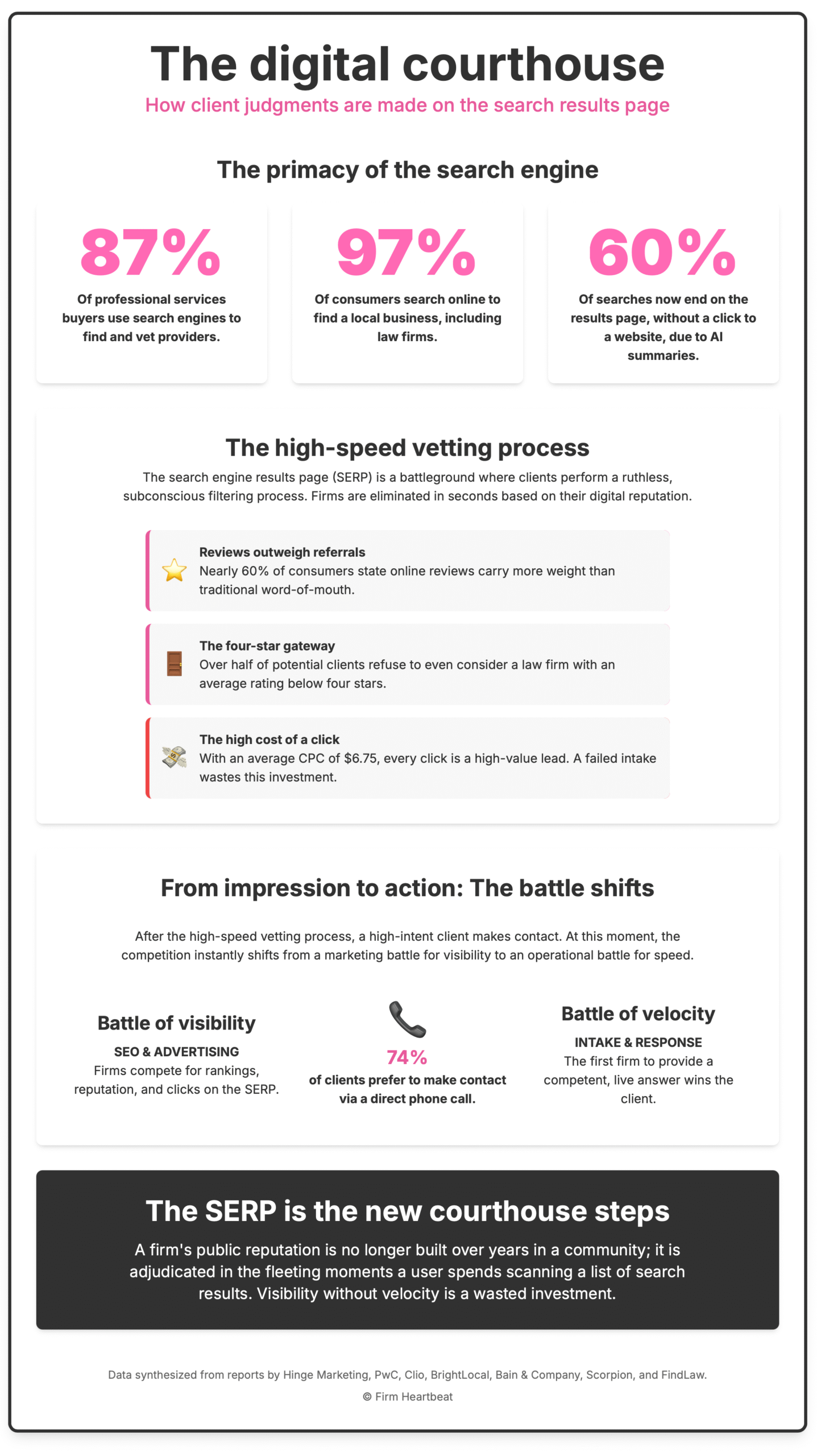
The universal law of speed-to-lead: quantifying the cost of delay
Cross-industry benchmarks: the irrefutable data on response time
The critical importance of rapid lead response is not a concept unique to the legal field; it is a universal business principle supported by extensive, authoritative research across all industries. This data provides an objective, quantitative foundation for understanding the staggering cost of delay. A landmark study published in the Harvard Business Review, which analyzed thousands of leads, found that firms that attempted to contact a potential customer within one hour of receiving an inquiry were nearly seven times more likely to qualify that lead—defined as having a meaningful conversation with a key decision-maker—than those that tried to contact the customer even an hour later.8
The consequences of even minor delays are severe. The same research revealed that moving from a 5-minute response time to a 10-minute response time decreases the odds of qualifying a lead by a staggering 400%.10 This is not a gradual decline but a precipitous drop in viability.
Perhaps the most compelling statistic, cited across numerous studies, reframes the entire competitive landscape. An incredible 78% of customers buy from the first company that responds to their inquiry.9 This finding has profound implications for law firms. It suggests that for the vast majority of potential clients, the selection process is not about finding the “best” or most qualified firm in the abstract; it is about finding the first qualified firm that is available and responsive to their immediate needs. The competitive advantage, therefore, shifts from perceived expertise to demonstrable availability.
The “platinum minute” and “golden window”: A statistical deep dive
The value of a new lead is not static; it decays exponentially with each passing moment. Analysis of lead response data reveals critical timeframes where the probability of conversion plummets. Understanding these windows is essential for designing an effective intake system.
- The Platinum Minute (under 60 seconds): The first minute after a lead is generated represents the period of maximum opportunity. Research from Velocify found that responding to a lead within this “platinum minute” can boost conversion rates by an astonishing 391%.8 The value erodes with shocking speed; waiting just one additional minute for a two-minute response time cuts the conversion lift by more than half, to a still-significant but much-diminished 160% improvement.8
- The Golden Window (under 5 minutes): This five-minute mark is widely regarded as the absolute maximum acceptable response time for a new lead. The benefits of operating within this window are immense. Data shows that a firm is 21 times more likely to qualify a lead if it responds within five minutes compared to waiting 30 minutes.11 Furthermore, the odds of even connecting with that lead—simply getting them on the phone—are 100 times higher in the first five minutes versus waiting just half an hour.11
- The Cliff (over 5 minutes): The drop-off in opportunity after the five-minute mark is not a gentle slope; it is a cliff. After just five minutes, the odds of qualifying a lead plummet by 80%.11 This demonstrates that the window of peak client interest is incredibly brief. Once it closes, the lead is likely already engaging with a competitor.
This data paints a clear picture: the battle for a new client is a sprint measured in seconds and single-digit minutes. Firms that are not equipped to compete on this timescale are effectively forfeiting the race before it has even begun.
The legal industry’s response deficit: a chasm between expectation and reality
When the universal best practices for lead response are juxtaposed with the documented performance of the legal industry, a chasm of missed opportunity becomes apparent. The data reveals a systemic failure within the legal profession to meet the fundamental expectations of the modern consumer, creating a market ripe for disruption by more agile and technologically adept firms.
According to Clio’s Legal Trends Report, a staggering 42% of law firms take an average of three or more days to respond to a message from a new potential client.3 This is not a minor delay; it is a complete abdication of the principles of effective lead management. In a world where lead value evaporates in minutes, a multi-day response is equivalent to no response at all.
More recent data suggests this problem is not improving; it may be worsening. A 2024 secret shopper study, also conducted by Clio, found that of 500 law firms contacted, only 40% answered their phone calls, and a mere 33% responded to email inquiries.14 This means that nearly half of the law firms tested were “essentially unreachable by phone,” representing a fundamental breakdown in the most critical function of client acquisition.
This operational failure has direct consequences. Scorpion’s 2025 report found that 72% of potential clients will simply move on to another firm if they do not receive a response within 24 hours.6 The legal industry’s average performance is not just suboptimal; it is catastrophically misaligned with consumer behavior, creating a massive “first-mover” arbitrage opportunity. The market for legal services is intensely competitive, yet the data shows that the vast majority of firms are systemically slow. Because up to 78% of clients hire the first firm to respond, the primary competitive barrier at the point of acquisition is not legal expertise but operational velocity. A firm that can solve the logistical problem of responding within five minutes can systematically capture leads that their equally, or even more, qualified competitors have already paid to generate but have failed to service. This is a classic market inefficiency, allowing responsive firms to capitalize on the operational failures of the incumbents.
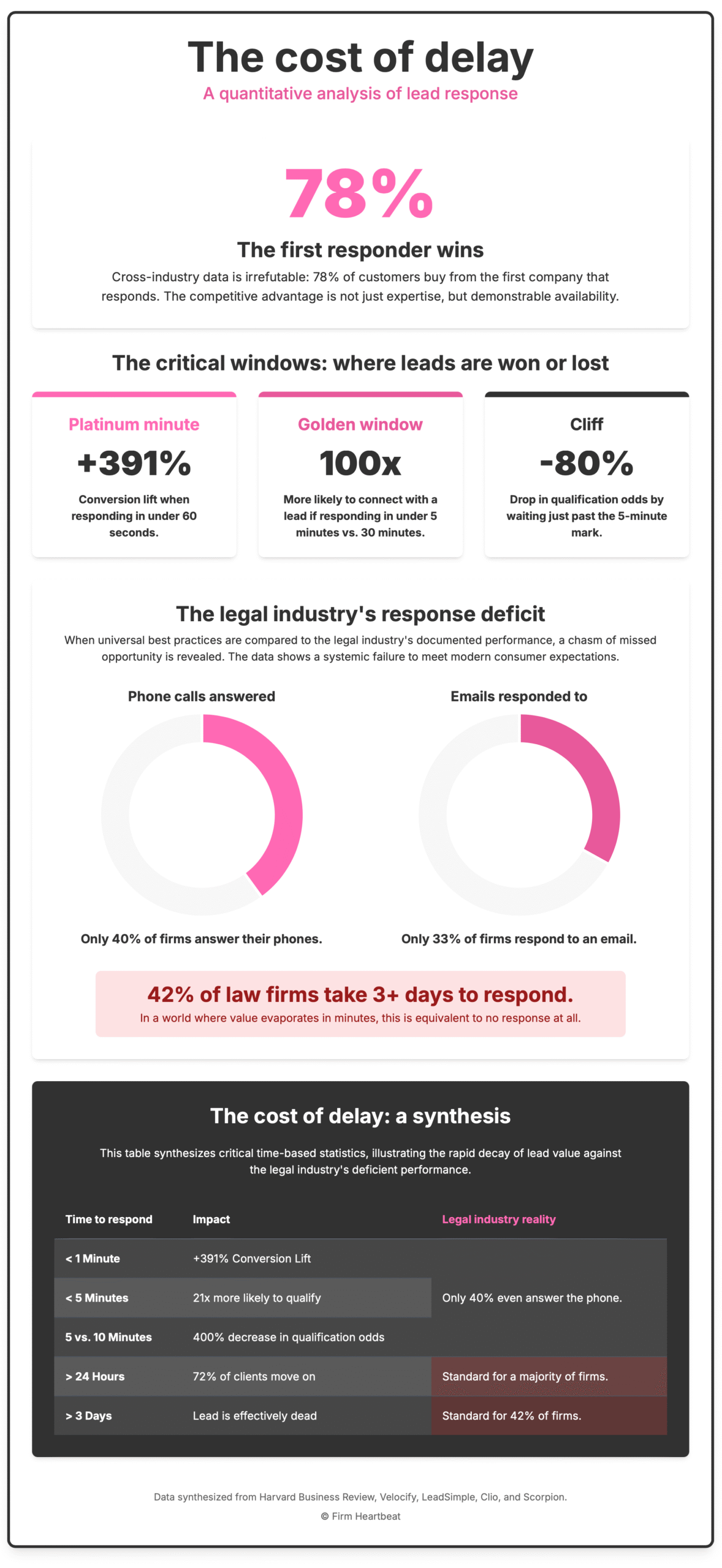
The dial tone of lost opportunity: an analysis of call abandonment
Defining and measuring call abandonment in a professional services context
For the majority of potential clients who prefer to make initial contact via telephone, the first measure of a firm’s responsiveness is whether the call is answered at all. Call abandonment rate is a critical Key Performance Indicator (KPI) that measures the percentage of inbound callers who hang up before ever speaking with a firm representative.15 This metric serves as a direct proxy for caller frustration and lost business opportunities.
In the context of a law firm, this KPI is particularly vital. The initial call is often from an individual in a state of heightened distress, anxiety, or urgency. They are not merely browsing; they are actively seeking immediate support and reassurance.17 Consequently, their tolerance for waiting on hold or listening to a phone ring endlessly is exceptionally low. Each abandoned call represents a potential client who has been turned away at the front door, most of whom will immediately proceed to call the next firm on their search results list.
The standard formula for calculating this rate is the number of abandoned calls divided by the total number of inbound calls, expressed as a percentage.19 It is a common best practice to exclude “short abandons”—calls that are disconnected within a very brief timeframe, typically 5 to 10 seconds. This adjustment accounts for misdials or callers who hang up instantly for reasons unrelated to the firm’s responsiveness, thereby providing a more accurate measure of true abandonment due to wait times.20
Industry benchmarks and the high cost of a dropped call
To effectively manage call intake, law firms must understand the quantitative benchmarks that separate acceptable performance from costly failure. Across various industries, an acceptable call abandonment rate is typically considered to be in the range of 2% to 5%.19 Performance between 5% and 8% is generally seen as average, while any rate exceeding 10% is indicative of significant operational problems and a poor client experience.16
For the consumer and professional services sector specifically, the average call abandonment rate has been measured at approximately 6.59%.21 However, because an inquiry from a new potential client is functionally a high-intent sales call, firms should aspire to the more stringent benchmark for revenue-oriented call centers, which is an abandonment rate of under 5%.16
The financial consequences of a high abandonment rate are severe and direct. Research shows that the damage is often permanent; nearly six out of ten customers will not attempt to call back after being kept on hold for too long, and a significant 32% will never return to that business at all.20 Each dropped call is not just a lost lead but often a permanently lost client, who may also share their negative experience with others, compounding the damage to the firm’s reputation. A high call abandonment rate is therefore a leading indicator of systemic operational flaws that likely extend beyond the intake process. The primary drivers of abandonment are long wait times, which are a direct result of understaffing, inefficient call routing, or a lack of available personnel.16 If a firm is failing to adequately resource the most critical point of revenue generation—new client intake—it is highly probable that similar inefficiencies and resource allocation issues exist in other client-servicing areas. Thus, the call abandonment rate serves as a powerful diagnostic tool for assessing the overall operational health and client-centricity of the firm.
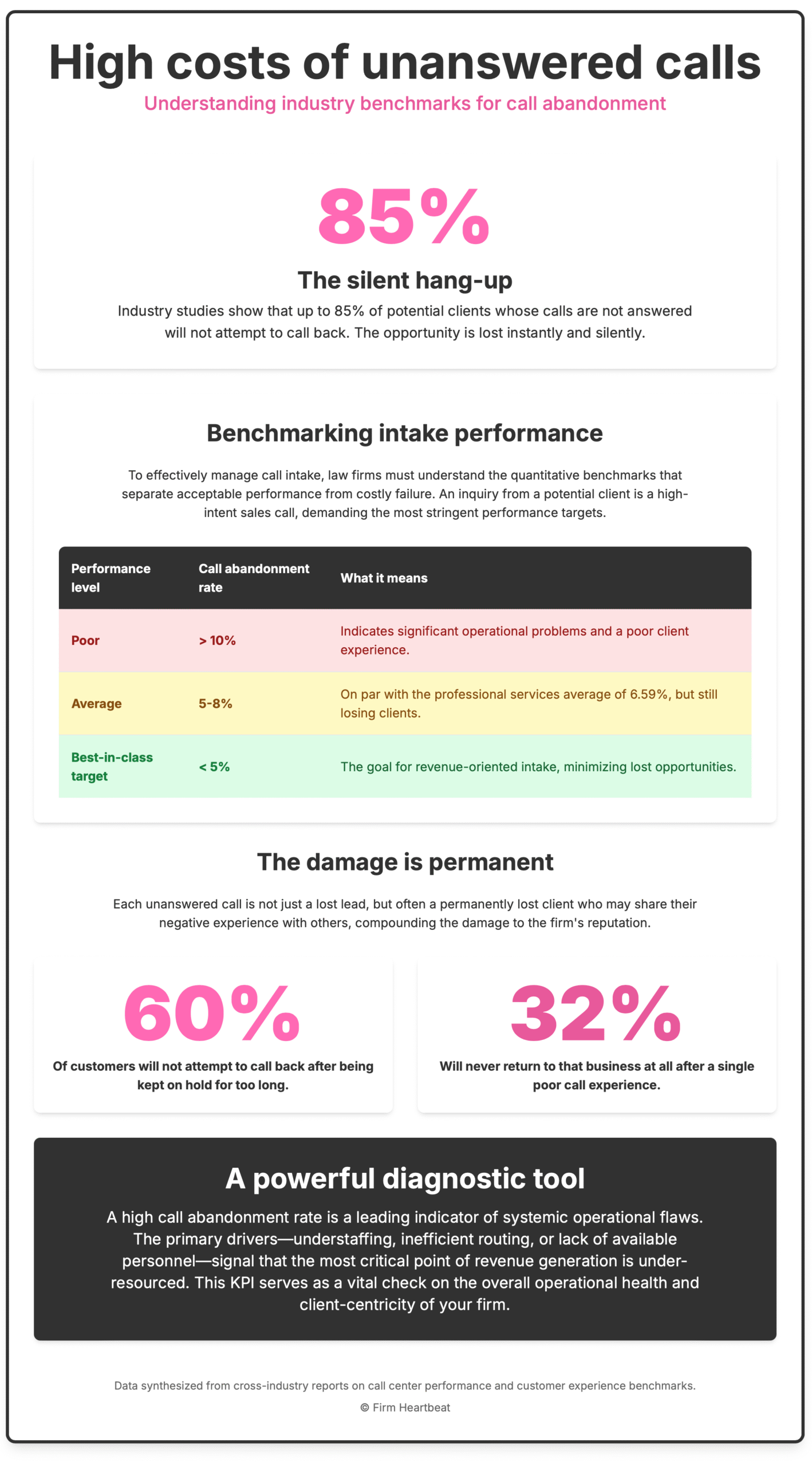
Critical time thresholds: the tipping points for caller patience
The decision to abandon a call is not made after minutes of waiting, but after seconds. Data on caller behavior reveals specific, critical time thresholds where patience evaporates and the likelihood of a hang-up skyrockets. Understanding these tipping points is essential for setting actionable service level targets for a firm’s intake team.
Research on customer service interactions has identified two critical points in the call waiting journey where the majority of customers choose to abandon the call: at 30 seconds and again at 60 seconds.23 This indicates that if a potential client’s call is allowed to ring unanswered for more than 30 seconds, the firm has already entered a high-risk zone for losing that lead forever.
This data has led to the establishment of a clear, best-in-class performance standard for call centers across all industries: the goal is to answer 80% of all inbound calls within 20 seconds.23 This “80/20” rule provides a concrete, measurable, and achievable target for law firms seeking to optimize their intake process. This 20-second service level target reveals that the competitive timeframe for winning a phone lead is measured in rings, not minutes. A standard phone ring cycle is approximately six seconds (four seconds of ringing followed by two seconds of silence). Therefore, the best-in-class standard of answering within 20 seconds means picking up the phone before the fourth ring. Given that most callers abandon after 30 to 60 seconds (five to ten rings), the entire competitive interaction for a phone lead is often won or lost before a standard voicemail system even has a chance to engage. The strategic imperative is not to call back quickly, but to prevent the need for a callback in the first place by answering the initial call immediately.
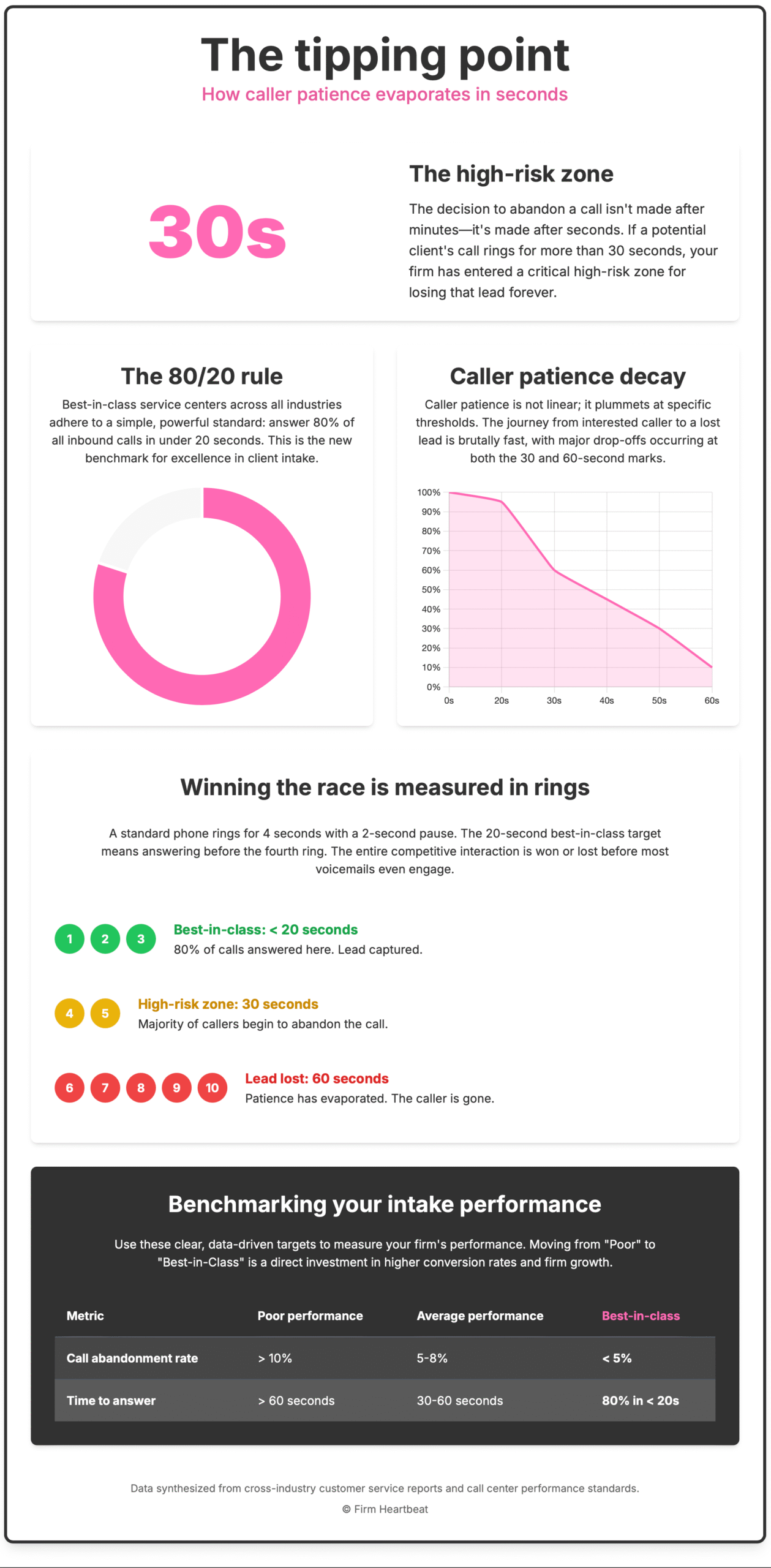
The psychology of immediacy: why potential clients refuse to wait
The client’s state of mind: urgency, anxiety, and the need for reassurance
To fully grasp why immediate response is paramount, one must move beyond quantitative data and analyze the psychological state of the individual seeking legal help. Unlike a typical consumer, a person contacting a law firm is often navigating a moment of significant personal crisis, dealing with a high-stakes, emotionally charged issue that threatens their financial stability, family structure, or personal freedom.24 Their decision-making is not purely rational; it is heavily influenced by powerful emotional drivers.25
Drawing from Maslow’s hierarchy of needs, these individuals are often operating from a deficit in their most fundamental needs for safety and security.25 They are seeking not just legal advice, but reassurance, guidance, and a sense of control over a chaotic situation. An unanswered phone call or a delayed email response does not merely inconvenience them; it directly conflicts with these core psychological needs. It amplifies their anxiety, reinforces their sense of helplessness, and sends a clear, albeit unintentional, message that their urgent problem is not a priority for the firm.18 In this context, a law firm’s intake process is not a sales function; it is a psychological triage unit. Failure to treat it as such represents a fundamental misunderstanding of the client’s emotional state. A potential client in crisis requires a process designed not just to qualify them, but to quickly assess their situation, calm their immediate fears, and provide a clear path forward. Firms that design their systems and train their staff for immediate reassurance and empathy will vastly outperform those that view intake as a mere administrative or sales-oriented task.7
Cognitive biases and the perception of competence
The human brain relies on mental shortcuts, or cognitive biases, to make rapid judgments, and these biases play a powerful role in how a potential client perceives a law firm based on their initial interaction. An immediate response leverages these biases to the firm’s advantage, while a delay triggers them to the firm’s detriment.
- The Halo Effect: A prompt, professional, and empathetic initial response creates a powerful positive first impression. This triggers the halo effect, a cognitive bias where this positive experience colors the potential client’s entire perception of the firm. They subconsciously infer that a firm so efficient and attentive at intake will be equally competent and diligent in handling the complexities of their legal case. The initial responsiveness becomes a proxy for overall quality.
- Confirmation Bias: Conversely, a slow response or an unanswered call often confirms a potential client’s pre-existing negative stereotypes about lawyers being unresponsive, arrogant, or difficult to work with. The client’s brain seeks to justify their decision to move on to the next firm on the list, and the firm’s unresponsiveness provides the perfect, irrefutable evidence.
The intake experience is therefore not a separate, preliminary step; it is perceived as a direct sample of the legal service to come. A failure in this initial interaction signals to the potential client that they can expect future failures in communication, attentiveness, and overall service delivery, making the decision to look elsewhere a logical and self-protective one.6
The principle of least effort and the frictionless alternative
Modern consumer behavior is governed by the principle of least effort—the tendency to choose the easiest path to a desired outcome.28 Digital technology has conditioned consumers to expect frictionless experiences, and their tolerance for any form of delay or inconvenience is near zero.
Waiting on hold, navigating a confusing phone menu, leaving a voicemail with no certainty of a return call, or filling out a web form with no immediate confirmation all represent points of friction. These moments of friction create a cognitive load and a sense of uncertainty for the potential client. In contrast, the alternative is readily available and completely frictionless: returning to the Google search results page and clicking the very next link.
In this dynamic, a law firm’s primary competitor is not just the firm listed below it on the SERP; it is the “back” button on the browser. The sheer ease with which a potential client can find an alternative means that their motivation to tolerate any delay is virtually nonexistent. The decision to hang up and call the next firm is not an act of mere impatience; it is an immediate and rational economic choice made by the consumer. They possess a valuable commodity—their time and attention—and are presented with a list of functionally similar service providers on the SERP. When a firm fails to answer, it signals a high potential “cost” to the consumer in the form of wasted time, future unresponsiveness, and mounting frustration. The “cost” of switching to the next provider is zero. Therefore, abandoning the call is a logical and efficient market behavior designed to minimize personal cost and maximize the probability of a successful and timely outcome.
Building trust from the first second
Ultimately, the client-attorney relationship is built on a foundation of trust. That foundation is laid not during the first formal consultation or upon the signing of a retainer agreement, but in the very first seconds of interaction. An immediate response is the first, and arguably most critical, act of building that trust.
It communicates a profound level of respect for the potential client’s time and an acknowledgment of the urgency and importance of their problem.18 It demonstrates that the firm is organized, attentive, and client-focused from the outset. This initial act of trust-building serves as a powerful psychological anchor. It can positively influence the entire subsequent relationship, smoothing the path for fee negotiations, fostering greater client cooperation, and dramatically increasing the likelihood that the client will become a source of positive online reviews and future referrals. Speed is not just a logistical advantage; it is the currency of modern trust.
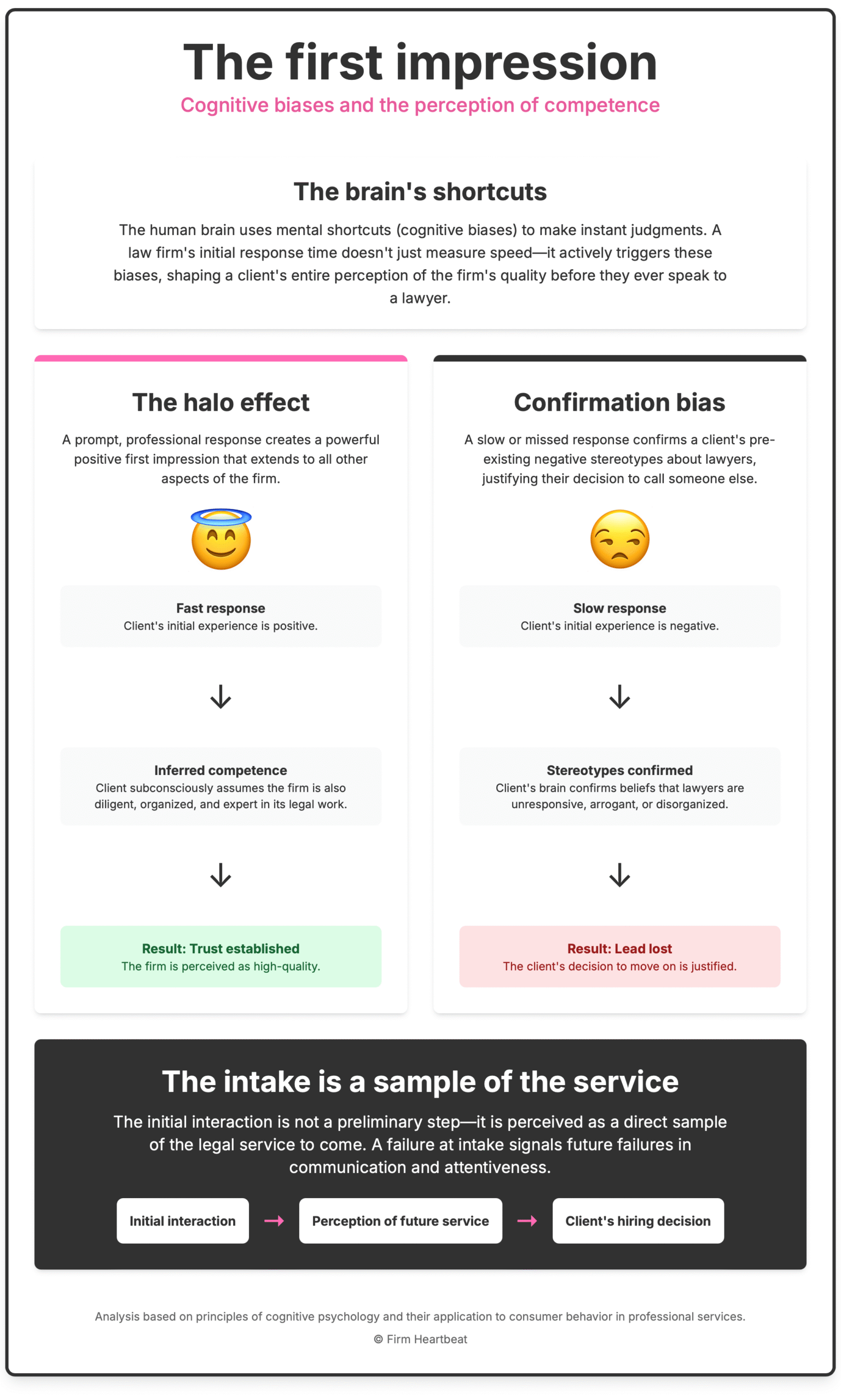
Synthesis: The unbreakable link between intake performance, marketing ROI, and market position
The vicious cycle: how poor intake invalidates marketing and SEO investment
The preceding analysis creates an unbreakable chain of causality that links a law firm’s intake performance directly to its financial health and market position. A failure to optimize for speed creates a vicious cycle that systematically undermines the firm’s investment in growth. A firm can allocate a substantial budget to search engine optimization, pay-per-click advertising, and brand-building campaigns to achieve a coveted top position on Google. However, if that same firm then takes 42 hours to respond to the high-intent leads generated by that investment, it has effectively nullified its marketing efforts.3
Slow response time is not a minor operational inefficiency; it is a systemic financial drain that invalidates marketing spend. Each unanswered call or delayed email response represents a marketing dollar that has been spent to acquire a lead for a more responsive competitor. This is not a passive loss of opportunity but an active subsidization of the competition.
Furthermore, this failure to engage has long-term consequences. Data indicates that failing to respond to leads promptly can increase a firm’s client churn rate by as much as 15%, as the initial poor experience erodes any chance of building loyalty.8 This creates a cycle where the firm must spend more on marketing to replace the clients it lost due to its own operational failures, leading to escalating costs and diminishing returns.
The virtuous cycle: how superior responsiveness creates a competitive moat
Conversely, a high-performance intake system that prioritizes immediate response creates a powerful virtuous cycle and a durable competitive advantage. By architecting a system to respond within the “golden window” of five minutes, a firm maximizes the return on investment (ROI) for every marketing dollar it spends. It converts a much higher percentage of its expensive, high-intent clicks into retained clients, dramatically lowering its effective cost per acquisition.
This increased efficiency generates more revenue from the same marketing budget, which can then be strategically reinvested into further marketing and technology, creating a flywheel effect of growth. This observation is supported by data from Clio, which shows that firms with above-average productivity—a direct result of leveraging technology—invest 41% more in marketing and, in turn, see a 21% increase in overall profitability.14
Furthermore, a superior intake experience does more than just convert a single lead. It delights the potential client at a moment of high stress, laying the groundwork for a positive relationship. This positive experience is a powerful driver of positive online reviews and word-of-mouth referrals, which are among the most valuable and cost-effective sources of new business.26 Over time, this builds the firm’s reputation, improves its online visibility, and lowers its future client acquisition costs. This creates a “competitive moat” that is incredibly difficult for slower, less operationally disciplined competitors to cross.5 Intake performance is thus the ultimate arbiter of a law firm’s marketing ROI. It functions as a multiplier on marketing effectiveness; a world-class intake system can make an average marketing campaign profitable, while a broken intake system will bankrupt even the most brilliant marketing strategy.
Modeling the financial impact: from response times to revenue
The cost of a deficient intake process can and should be quantified. Law firm leadership can use a simple model to estimate the tangible revenue being lost each month due to slow or missed responses. The basic formula is as follows: Monthly Revenue Lost=(Total Inbound Leads per Month)×(Lead Forfeiture Rate)×(Average Case Value).
Where the “Lead Forfeiture Rate” is the percentage of leads that are lost due to the firm’s inability to respond within the competitive five-minute window.
Worked Example: Consider a hypothetical personal injury firm that generates 100 new inbound leads per month through its website and marketing efforts.
- Total Inbound Leads: 100
- Average Case Value (Net Fee): $15,000
- Current Intake Performance: The firm, like many, responds within an average of 24 hours. Based on the data that 78% of clients hire the first responder, and competitors are likely responding faster, we can conservatively estimate a Lead Forfeiture Rate of 50%. This assumes half of the leads have already retained a competitor by the time the firm responds.
- Calculation: 100 Leads×50% Forfeiture Rate×$15,000 Average Case Value=$750,000 in Monthly Lost Revenue Potential. This translates to $9,000,000 in potential annual revenue left on the table, not because of a lack of leads, but because of a failure in the intake process. Even with a more conservative forfeiture rate of 20%, the lost potential revenue is $3.6 million annually. This model demonstrates that optimizing the intake process is not a cost center but one of the highest-return investments a firm can make.
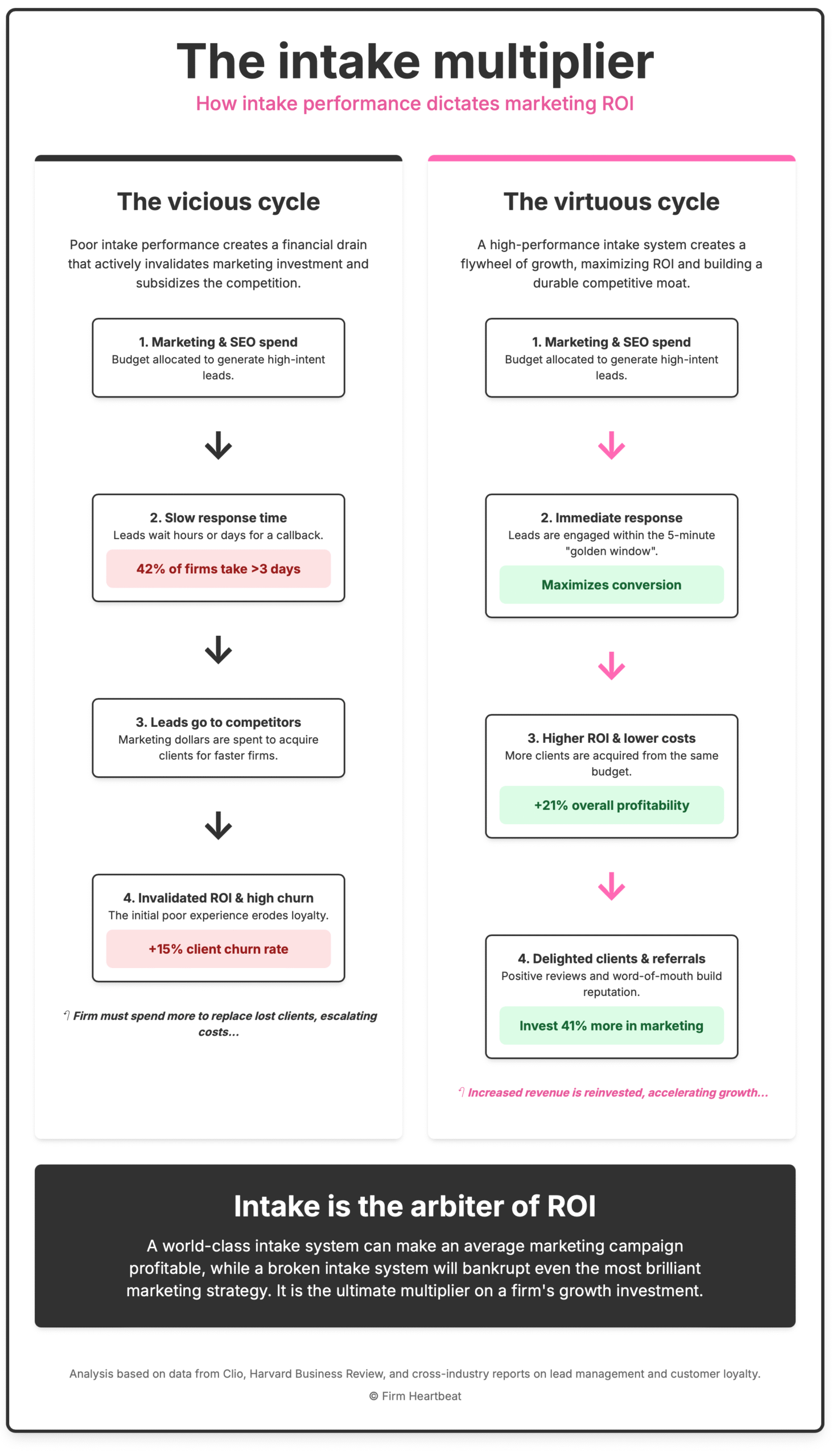
Strategic imperatives: architecting a high-conversion client intake system
Auditing and benchmarking: the first step to transformation
The journey toward a high-conversion intake system begins with an honest and data-driven assessment of the firm’s current performance. A firm cannot improve what it does not measure. The first strategic imperative is to establish a baseline by systematically tracking the key performance indicators identified in this report. This involves implementing a clear methodology for measuring:
- Speed-to-Lead: For both web form submissions and phone calls that go to voicemail, what is the average time elapsed between the client’s inquiry and the firm’s first response attempt?
- Call Abandonment Rate: What percentage of inbound callers hang up before speaking with a live person?
- Service Level: What percentage of inbound calls are answered within the 20-second best-practice threshold?
Accurately tracking these metrics requires moving beyond manual logs and spreadsheets. The use of a legal-specific Customer Relationship Management (CRM) system or dedicated client intake software is essential. This is a foundational step, yet data from Clio’s report indicates that a shocking 26% of law firms do not track their leads at all.3 This represents a fundamental failure in business management and is the single largest obstacle to improvement. Without data, any attempt to enhance the intake process is merely guesswork.
The role of technology in creating competitive advantage
Technology is the enabler that makes a sub-five-minute response time not just possible, but scalable and efficient. A critical strategic blind spot has emerged in the legal industry: while AI adoption for internal, billable tasks has skyrocketed from 19% to 79% in a single year, client-facing responsiveness has simultaneously declined.14 This reveals a tendency to prioritize the optimization of existing work over the acquisition of new revenue. The strategic opportunity lies in redirecting this technological focus to the firm’s front door.
- Foundational Tools: A legal-specific CRM is the indispensable starting point. It provides a centralized system for tracking every lead, managing follow-ups, and analyzing performance data, ensuring no potential client falls through the cracks.3
- Automation: Simple automation can have a profound impact. Implementing automated lead nurturing systems, such as an instant email or SMS message that acknowledges receipt of a web form submission, can bridge the crucial gap before a human can respond. This simple act confirms to the client that their inquiry was received and is being addressed, dramatically reducing their incentive to immediately contact a competitor.7
- AI-Powered Intake: The most transformative technology available is Artificial Intelligence. AI-driven intake systems are no longer a futuristic concept but a present-day reality that directly solves the core challenges of speed and availability. These systems can provide 24/7 instant responses via chat or voice, intelligently qualify leads by asking preliminary questions, schedule consultations directly on attorneys’ calendars, and seamlessly integrate with the firm’s case management software.24 The impact is dramatic and proven. Case studies show that:
- Firms implementing AI intake capture 300% more qualified leads than their competitors.30
- A personal injury firm that used AI to reduce its response time from 45 minutes to under 30 seconds saw a 40% increase in client conversions.29
- A family law firm that replaced its traditional after-hours call center with an AI solution cut its staffing expenses by 60% while simultaneously increasing booked consultations by 25%.29
Operational Excellence: Integrating people, process, and technology
Technology, while powerful, is not a complete solution in itself. Achieving operational excellence in client intake requires a holistic approach that seamlessly integrates people, processes, and technology into a cohesive system.
- People: The human element remains critical. Intake staff, whether in-house or outsourced, are the firm’s ambassadors. They must be trained not only in the firm’s procedures but also in the essential soft skills of active listening, empathy, and providing reassurance. Empowering this team with the authority and information to answer basic questions and set clear expectations for next steps can significantly enhance the client experience and build immediate trust.7
- Process: The firm must establish and document clear Standard Operating Procedures (SOPs) for the entire intake process. These SOPs should govern every step, from the initial answering script to lead routing protocols that ensure inquiries are directed to the correct person immediately. They should also define the workflow for follow-up, ensuring persistence without being intrusive, and facilitate clear communication channels between the intake team and the legal staff.7
- Integration: The technology must serve the people and the process, not the other way around. The CRM and any AI tools must be seamlessly integrated into the daily workflow of the intake team and attorneys. Data should flow automatically, tasks should be triggered without manual intervention, and the system as a whole should reduce friction, not create it.
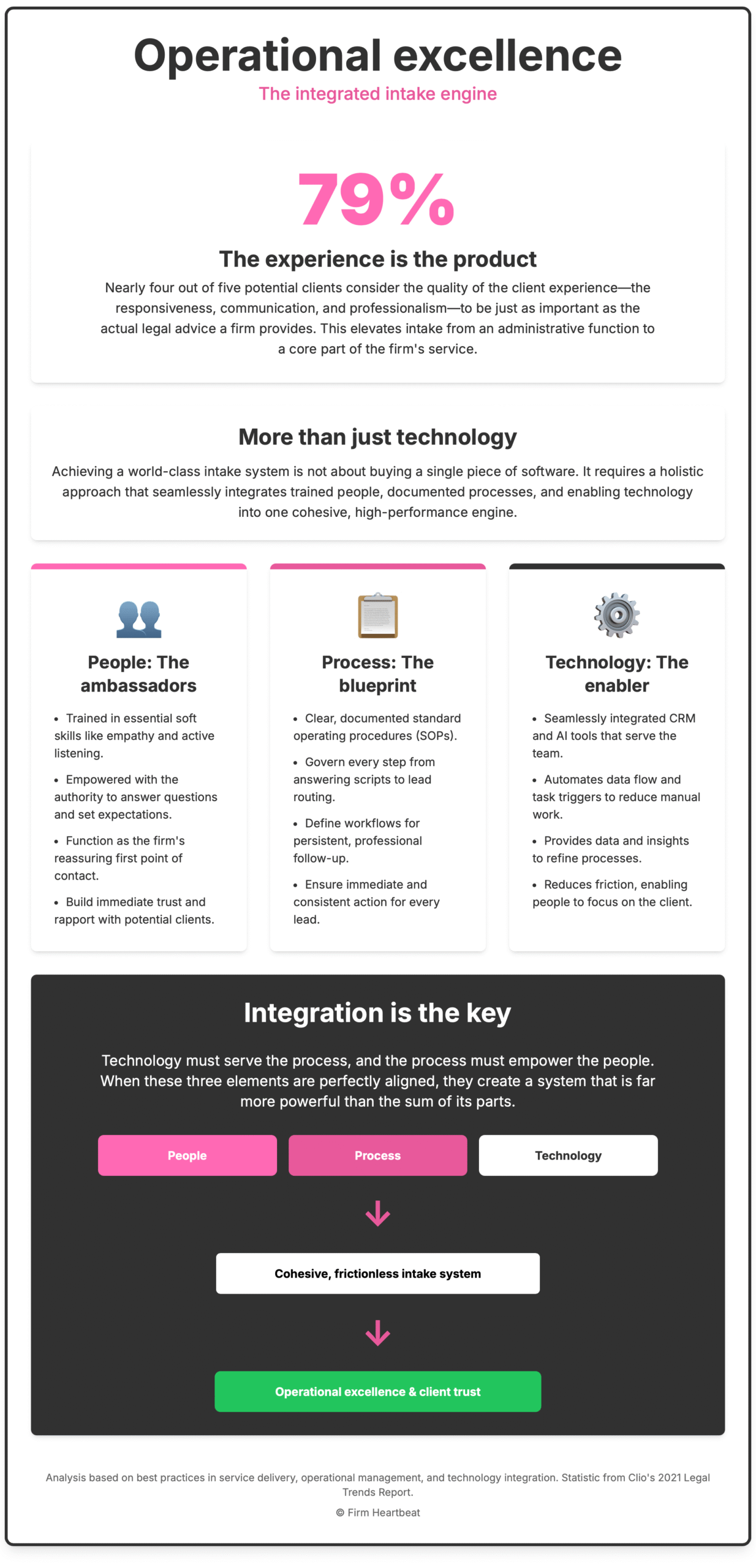
Transforming intake from a cost center to a revenue driver
The evidence presented throughout this report converges on a single, unequivocal conclusion: in the contemporary legal market, client intake is no longer a passive, administrative function. It is the firm’s primary revenue-generating engine and the principal arena of competitive differentiation. The traditional model of responding to potential clients within days, or even hours, is obsolete and financially ruinous.
The race for new clients is a sprint, not a marathon. It is won or lost in the first five minutes. The data is clear: the first firm to respond captures the overwhelming majority of the business. A potential client’s decision to abandon a call or move to the next search result is not an act of impatience but a rational response to a market that offers frictionless alternatives. Their initial interaction with a firm—or lack thereof—serves as a powerful proxy for the quality of service they expect to receive, triggering deep-seated psychological biases that shape their entire perception of the firm’s competence and professionalism.
Firms that continue to view intake as a low-priority cost center, that fail to invest in the necessary technology, and that do not hold themselves accountable to the rigorous, data-driven benchmarks of the modern service economy are making a strategic error from which they may not recover. They are actively invalidating their marketing investments and ceding market share to more agile competitors.
The strategic imperative is clear. Law firms must architect their people, processes, and technology with a singular goal: to win the first five minutes. Those that embrace this challenge—by implementing modern CRM and AI-powered systems, by training their staff for empathetic and immediate engagement, and by relentlessly measuring and optimizing their performance—will build a virtuous cycle of growth. They will maximize their marketing ROI, generate superior revenue, and build a powerful, defensible market position. For the modern law firm, the choice is no longer whether to invest in intake optimization, but whether it can afford not to.
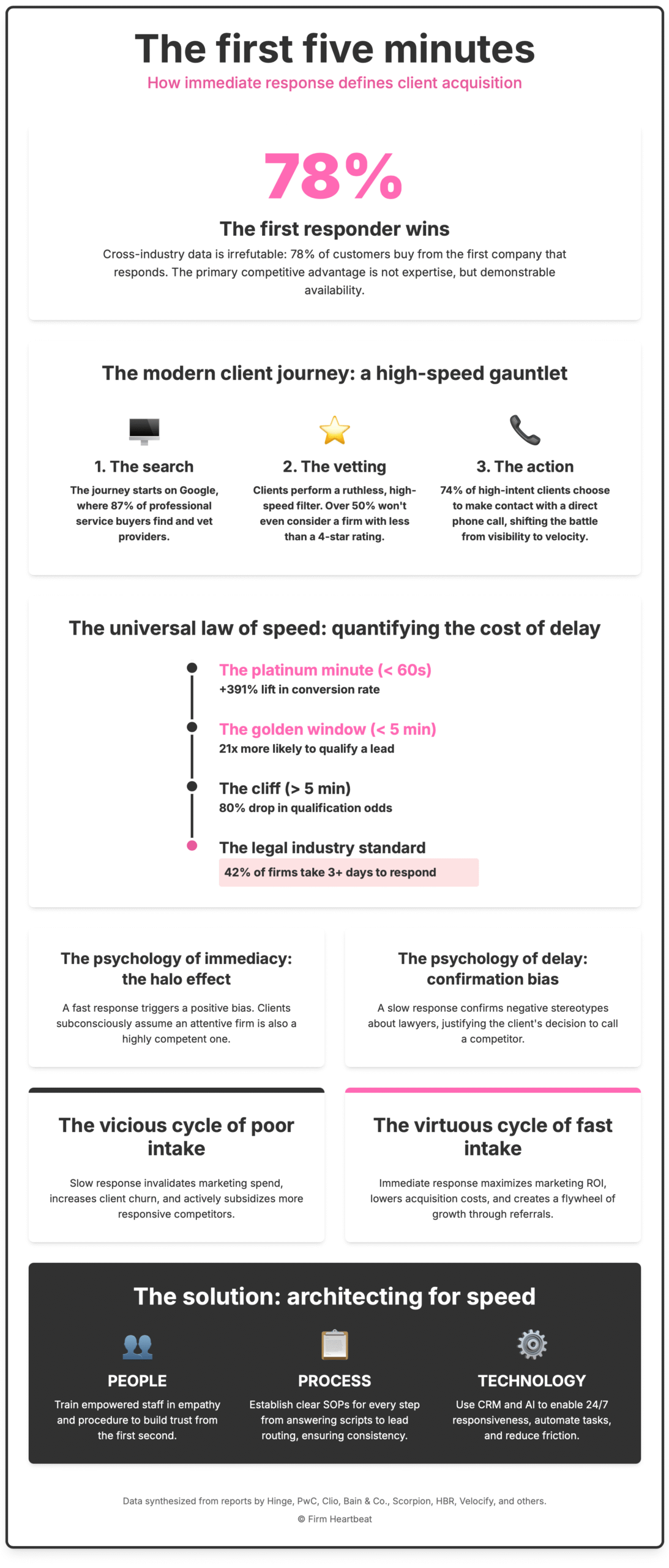
Frequently asked questions
Why are the first five minutes after a potential client contacts my firm so important?
The first five minutes are the entire race. Data shows that 78% of clients hire the first firm that responds to their inquiry. The battle for a new client is won or lost almost immediately.
The drop-off is incredibly steep. Responding within five minutes instead of 30 makes your firm 21 times more likely to qualify the lead. In fact, your odds of even connecting with that lead are 100 times higher in that initial five-minute window. After just five minutes, the probability of qualifying a lead plummets by 80%.
How is my firm’s online reputation affecting client acquisition before I ever speak to anyone?
Your online reputation is your new front door, and clients are making judgments in seconds. The Search Engine Results Page (SERP) is where most potential clients first encounter your firm, and their vetting process is ruthless.
Consider these key statistics:
- Nearly 60% of consumers now say online reviews are more influential than traditional word-of-mouth referrals.
- Over half of potential clients will refuse to even consider a law firm with an average rating below four stars.
A low star rating or negative reviews can eliminate your firm from consideration before you even know a potential client was looking.
How slow are most law firms, and what’s the opportunity for my firm?
The legal industry’s performance is catastrophically misaligned with modern consumer expectations, which creates a massive competitive advantage for any firm that can be fast.
The data reveals a systemic failure:
- A shocking 42% of law firms take three or more days to respond to a new inquiry.
- A 2024 study found that nearly half of the law firms tested were “essentially unreachable by phone,” with only 40% answering their calls.
- This is a critical failure, as 72% of potential clients will simply move on to another firm if they don’t get a response within 24 hours.
Because most clients hire the first responder, your primary competitor isn’t the most experienced firm; it’s the fastest firm. By simply solving the logistical problem of a five-minute response, you can systematically capture high-value leads that your competitors have already paid to generate.
We use voicemail and call people back. Isn’t that sufficient?
No, relying on voicemail is a recipe for lost revenue. The modern client’s tolerance for waiting is measured in seconds, not minutes.
The best-in-class standard is to answer 80% of calls within 20 seconds—that’s before the fourth ring. Most callers who abandon a call do so between 30 and 60 seconds. This means the entire window of opportunity closes before a standard voicemail system even picks up.
The damage is often permanent. Research shows that 32% of people whose calls go unanswered will never return to that business. An unanswered call isn’t a delayed lead; it’s a lost client who is now calling your competitor.
Why are potential clients so unwilling to wait?
It’s not simple impatience; it’s a reaction driven by deep psychological needs. A person seeking legal help is often in a state of crisis, feeling a profound loss of safety and security.
- Urgency and Anxiety: They need reassurance and a sense of control. An unanswered call or a delayed email amplifies their anxiety and reinforces their feeling of helplessness. A fast response signals that their problem is a priority.
- The Halo Effect: A prompt, professional first interaction creates a powerful “halo effect.” The client subconsciously assumes that a firm so responsive at intake will be just as competent and diligent in handling their legal case. A slow response confirms negative stereotypes about lawyers being unresponsive.
- Principle of Least Effort: The alternative—clicking the “back” button and calling the next firm on Google—is completely frictionless. Any delay from your firm makes this the most logical and rational choice for the consumer.
How can my firm realistically achieve a sub-five-minute response time?
Achieving this speed requires a strategic integration of people, process, and technology. Technology is the key enabler. While many firms have adopted AI for internal tasks, the biggest opportunity lies in using it for client-facing intake.
AI-powered intake systems can provide:
- 24/7 Instant Response: Engage every lead immediately via chat or voice, even after hours.
- Automated Qualification: Ask key questions to qualify leads without human intervention.
- Automated Scheduling: Book qualified consultations directly on attorneys’ calendars.
The results are transformative. Case studies show that firms using AI intake capture 300% more qualified leads, and one firm saw a 40% increase in client conversions after cutting its response time from 45 minutes to under 30 seconds.
What is the first practical step I should take to improve my intake process?
You cannot improve what you do not measure. The first step is to conduct a data-driven audit of your current performance. Shockingly, 26% of law firms don’t track their leads at all.
Begin by systematically measuring these Key Performance Indicators (KPIs):
- Speed-to-Lead: What is your average response time for web forms and voicemails?
- Call Abandonment Rate: What percentage of callers hang up before speaking to a person?
- Service Level: What percentage of your calls are answered within the 20-second best-practice threshold?
Implementing a legal-specific CRM or client intake software is the most effective way to track these metrics accurately. This data will give you a clear baseline and reveal the most critical areas for improvement.
Sources
- Unlock the Power of SEO & SEM: Essential Strategies for Professional Services
- June 2023 Global Consumer Insights Pulse Survey
- Key Legal Digital Marketing Statistics For Law Firms
- Consumer reliance on AI search results signals new era of marketing
- Search Engine Marketing for Law Firms
- New Report Finds 74% of Legal Clients Research Firms After a Referral, Redefining the Role of Word-of-Mouth in 2025
- What is Legal Intake? 6 Tips for a Great Law Practice
- The Impact of Lead Form Response Time: The Secret Weapon That Dramatically Increases Client Conversions
- Speed to Lead: Speed is the Key to Lead Conversion
- We Tested 114 B2B Companies’ Lead Response Times. Here’s What We Learned
- The Impact of Speed to Lead: Response Time Statistics That Drive Conversions
- Respond to Leads Immediately, or Conversions Drop Sharply
- How Faster Lead Response Times Can Skyrocket Conversions
- AI-powered legal practices surge: Clio’s latest Legal Trends Report
- Call abandonment rate
- What Is Abandonment Rate in a Call Center? A Complete Guide
- Outsource law firms call center services in 2025
- What is the Danger of Long Ring Times?
- Call abandonment rate – Basics, common mistakes, benchmarks
- Call Abandonment Rate: What Is It & How To Measure It?
- How to Calculate Call Abandonment Rate in 4 Steps (+ Calculator)
- Abandonment Rate: What’s Normal and How to Fix It
- Important Call Center Statistics to Know [2025]
- How AI is Changing Client Acquisition for Personal Injury Law Firms
- Psychology of Consumer Behavior: Understanding Your Market
- The Psychology of Consumer Choices and Business Success
- Consumer Psychology: Insights and Practical Applications
- Buyer Behavior: How Are Consumer Decisions Researched and Used in Business?
- How Many Calls Does Your Law Firm Miss After Hours?
- AI Intake Systems for Law Firms: Capture Leads 24/7













